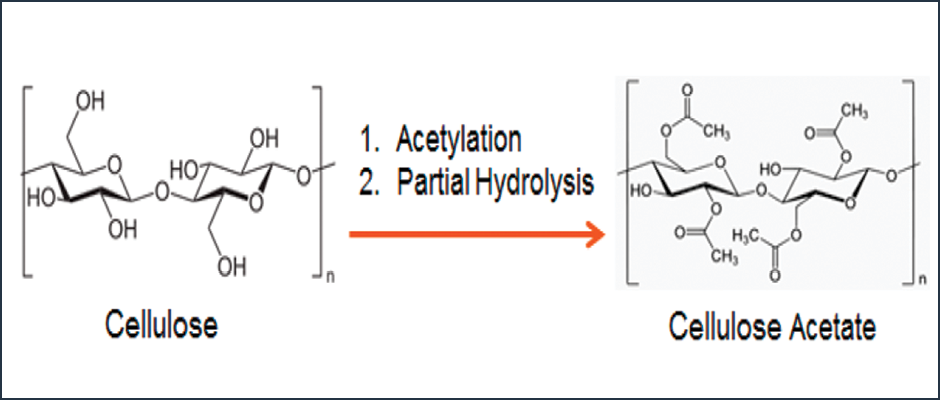Cellulose Acetate as a Tunable Bio-Based Engineered Material
Previous Article Next Article
By Naresh K. Budhavaram, Bing Lu, Christopher D. McGrady, Michael T. Combs, and Kevin Pan Celanese Corp., Dallas, Texas, USA
Cellulose Acetate as a Tunable Bio-Based Engineered Material
Previous Article Next Article
By Naresh K. Budhavaram, Bing Lu, Christopher D. McGrady, Michael T. Combs, and Kevin Pan Celanese Corp., Dallas, Texas, USA
Cellulose Acetate as a Tunable Bio-Based Engineered Material
Previous Article Next Article
By Naresh K. Budhavaram, Bing Lu, Christopher D. McGrady, Michael T. Combs, and Kevin Pan Celanese Corp., Dallas, Texas, USA

Figure 1: Cellulose acetate synthesis.

Table 1: Properties of Various Polymers

Figure 2: Mechanical properties of CA compounded with various levels of plasticizer (DEP).


Figure 3: Mechanical and thermal properties of CA with TA and DEP as plasticizers at constant plasticizer loading levels.

Figure 4a: Percentage change in mechanical properties of various plasticizers (Pz1, Pz2, Pz3) vs. TA.

Figure 4b: Percentage change in impact, DTUL, and density of various plasticizers vs. TA.

Figure 5a: Modulus of CA, PP, and CA-PP blends.

Figure 5b: Elongation of CA, PP, and CA-PP blends, with CA loading given as a percentage by weight.

Figure 5c: Tensile and flexural strength of CA, PP, and CA-PP blends.

Table 2: Nomenclature Used for CA-PP Blend Studies

Figure 6: Charpy notched impact strength (kJ/m2) for CA, PP, and CA-PP blends.

Figure 7a: Melt flow index (at 210°C, 2.16 kg) for CA, PP, and CA-PP blends.

Figure 7b: Melt viscosity (at 210°C) values obtained through a capillary rheometer for CA, PP, and CA-PP blend
[Ed. note: This is a reformatting of the authors’ ANTEC® Orlando 2015 paper. As of press time, the paper was scheduled to be presented at ANTEC in session T2 on Tuesday, March 24, at 9:00 AM.]
Cellulose acetate (CA) is one of the oldest plastics, with an application history dating back over 100 years. Recent drivers towards an engineered bio-based material that can be used in demanding applications have caused revitalization in CA product development. This paper illustrates the ability to fine-tune mechanical and thermal properties through plasticizer selection. A case study is also presented where CA can be used to enhance the bio-content of petro-based plastics such as polypropylene (PP) while improving performance of the final blend.
Introduction
Bioplastics, or plastics derived from renewable biomass resources, are one of the fast growing segments of the plastics industry. Based on a European Bioplastics forecast, the global production capacities of bioplastics will increase from about 1.4 million tons to more than 6 million tons in the near term.1 Compared to traditional petroleum-based plastics, bioplastics can help reduce the dependency on limited fossil resources, and decrease overall greenhouse gas emissions or even approach carbon neutrality. In order to achieve such growth in bio-based materials, the material must be able to meet application-specific performance while maintaining a competitive cost structure.
Cellulose acetate plastics possess the unique potential to increase the application space of traditional bioplastics. CA is made of cellulose through acetylation and partial hydrolysis processes (Figure 1). Cellulose is one of the most abundant biopolymers on earth, rich in renewable biomass such as cotton and wood. CA was one of the dominant plastics in the early-to-mid 20th century, with wide applications in eyewear, fashion accessories, costume jewelry, handles, packaging, containers, toys, and utensils.
CA plastics often show a unique combination of properties that distinguish them from other thermoplastics. The broad spectrum of properties include high transparency, sensorial qualities (touch/visual appeal/comfort), high impact strength, low sensitivity to stress cracking, good chemical resistance, rapid loss of electrostatic charges, high resistance to surface leakage and good electrical insulation, unlimited capacity for coloration, and good printing/coating/bonding properties. The glass transition temperature (Tg) of CA is 160-180°C. This is high when compared to other bio-based materials (such as polylactic acid, whose Tg = 55-60°C).
CA plastics can begin to compete with other petroleum-based engineering plastics, as shown in Table 1. The properties of CA plastics are very tunable for applications through approaches including CA polymer modification, plasticization, polymer blends, and composites. For example, the heat deflection temperature (DTUL) at 0.45 MPa can be adjusted from below 50°C to values above 100°C. Biodegradability can be tuned from durable (biodegradation beyond five years) to compostable (in 180 days according to ASTM D6400 or EN14995). Renewable resources from agriculture and forestry provide the sustainability of CA production, and current large commercial manufacturing offers the economy of scale for further cost reduction of CA polymer.2
Materials
Cellulose diacetate (commonly referred to as cellulose acetate) flake and compounded pellets were obtained from Celanese Corporation. The polypropylene (PP) copolymer is an auto grade and is available commercially from Lyondell Basell. The melt flow index of the PP was 21, as measured at 210°C using a 2.16-kg load. The material properties of PP can be seen in Table 1 in comparison with other polymers, including cellulose acetate. Diethyl phthalate (DEP) and triacetin (TA) were obtained from Sigma Aldrich. All plastic formulations were compounded on a lab-scale proprietary twin screw extruder at Celanese.
Discussion
The melting point and degradation temperatures of CA are very close to each other. This impedes its thermal processability. Hence a plasticizer is needed to depress the melting temperature, allowing it to be compounded and injection molded into various articles.3 DEP is one of the most commonly used plasticizers for melt-extruding CA.
In the current work, benchmark studies have been performed using DEP at various levels. Figure 2 shows the properties of CA at various levels of DEP. From the figure it is clear that the plasticizer level significantly affects the mechanical properties of the molded article. Generally, the modulus and strength (both tensile and flexural) and DTUL decrease with an increase in plasticizer level, while the elongation and impact strength increase.
Though DEP has been traditionally used to make CA plastics, public perception of late is changing, due to regulations on other phthalate-based plasticizers such as DOP and DINP. Because of this reason, there has been a renewed effort focused on non-phthalate plasticizers as an alternative to DEP. Triacetin (TA) is a potential alternative plasticizer to DEP. Hence, this was selected as the model plasticizer in the current study and compared with DEP.
Figure 3 compares the efficiency of both the plasticizers. It can be noted that most of the properties remain unchanged, while elongation and impact strength are slightly better when DEP was used as the plasticizer. However, TA is a food-grade plasticizer, making it better suited to meet an increased application space relative to DEP.
Several other proprietary plasticizers were utilized to illustrate the tunability of the cellulose acetate resin for increased performance in more demanding applications. As can be seen in Figures 4a-b, out of the three plasticizers used, “Pz1” compares well with TA. “Pz1” shows positive changes in most of the properties. Only the Charpy notched impact strength is lower when compared to TA. This study shows that the properties are dependent on the type of plasticizer used. However, when compared with Figure 2, the dominating factor tends to be the plasticizer level more than the plasticizer type. Different applications demand different properties, and in CA plastics they can be fine-tuned by changing the plasticizer level and to some extent the plasticizer type.
To illustrate the effectiveness of CA in modern applications, a case study was performed looking at the blending properties of CA with PP. PP is a commonly used material in the automotive industry. One way to increase the biocontent of the base is through blends with a bio-based polymeric material.
PP is one of the most widely used commodity plastics in the world. PP, however, is not biodegradable. In several cases fillers like glass fibers are added to improve the mechanical properties in order to meet the demands of the application. By blending a bio-based (and biodegradable) material with PP, the environmental persistence of the resin becomes more favorable, providing the blend still meets the application requirements.
To this end there are several ongoing studies to use cellulosic fibers (CF) as an alternative to glass fibers (GF).4,5 The goal here is twofold. The first is to bring value through the addition of a bio-based product. The second is to lower the density by substituting high-density glass fibers with the low-density cellulose fibers. It was found that most of the properties improved or remained on par when CF was used instead of GF.
As the next natural step, the authors looked at studying the mechanical properties of CA-PP blends. In this case, CA is a thermoplastic and not a fiber. However, CA is biobased and, if compatible, could enhance the properties of CA-PP.
CA pellets from Celanese were used for this study. Different ratios of CA-PP were studied (up to a 50% blend of CA). In addition to CA and PP, a proprietary compatibilizer was added at various levels to increase the miscibility of the blend. The nomenclature for the following discussion has been listed in Table 2.
As shown in Figures 5a-c, the tensile and flexural properties of CA are better than PP, with the exception of elongation. When CA was blended at 20% and 25%, the properties were improved slightly versus pure PP. However, from 20% to 25%, a slight decrease in the properties could be noticed. This is due to the decrease in compatibility of the two polymers at increased levels of CA. Hence, a 25% CA level was selected and a proprietary compatibilizer was added to overcome this immiscibility.
From Figures 6 and 7a-b, the addition of CA at 20% and 25% had a negligible effect on the properties of pure PP. This implies that the bio-content of PP can be enhanced using CA while keeping the properties constant.
Adding the compatibilizer did not change the tensile and flexural properties at 25% CA. Therefore the effect of the compatibilizer was neutral. The same neutral effect was seen in the Charpy impact strength, as shown in Figure 6.
However, from Figures 7a-b it is evident that there is a significant effect of compatibilizer on the flow properties of the blend. The melt flow index (MFI) increases, and this reciprocates well with a decrease in melt viscosity with the addition of a compatibilizer. An increase in MFI would help in the injection moldability of the material. It would allow for the addition of greater amounts of fillers when compared to native PP.
Conclusions
Cellulose acetate plastics could be a potential solution to the environmental persistence created by traditional plastics. They are bio-based plastics with superior properties. The properties of the materials can be fine-tuned by adjusting the plasticizer level. CA can be effectively processed using food-grade plasticizers instead of phthalate-based plasticizers. CA can also enhance the bio-content of petro-based plastics. Especially in PP, the enhancement of flow could lead to many potential applications, while allowing for an increase in bio-content.
References
- www.en.european-bioplastics,org/market.
- P. Rustemeyer (Ed.), Macromolecular Symposia, 208 (2004).
- A.K. Mohanty, A. Wibowo, M. Misra, and L.T. Drazal. Polymer Engineering Science, 43, 1151-1161 (2003).
- S.M.L. Rosa, E.F. Santos, C.A. Ferreira, and S.M.B. Nachtigall. Materials Research, 12, 333-338 (2009).
- M. Pracella, M. M. Haque, and V. Alvarez. Polymers, 2, 554-574 (2010).